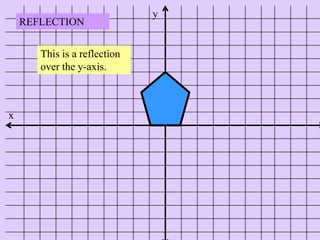


Draw a perpendicular PM from P to the line x = k and produce it to the point P' such that PM = MP'. So, the reflection in a line parallel to Y- axis means reflection in the line x = k.

The equation of a line parallel to Y- axis is given by x = k where k is X - intercept of the line. Reflection in the line parallel to Y- axis.Hence, if R denotes the reflection in the line y = k, then: ∴ Image of point P (x, y) after reflection in the line y = k is P' (x, 2k - y). ∴ Co- ordinates of the point P' are (x, 2k - y). Since, M is the mid-point of the line segment PP', then by mid- point formula, Let thye co- ordinates of P' be (x', y'). Then P' is the image of P after reflection in Draw a perpendicular PM from P to the line y = k and produce it to the point P' such that PM = PM'. So, reflection in the line parallel to X- axis means reflection in the line y = k. The equation of a line parallel to X- axis is given by y = k where k is Y- intercept of the line. Reflection in the line parallel to X- axis.Hence, if R y denotes the reflection in Y- axis, then: ∴ Image of point P(x, y) after reflection in Y- axis P' (-x, y). ∴ Co- ordinates of the point P' are (-x, y). Since M is the mid-point of line segment PP', then by mid- point formula, Then P' is the image of P after reflection in Y- axis. Draw a perpendicular PM from the point P to the Y- axis and produce it to the point P' such that PM = MP'. So, reflection in Y- axis means reflection in the line x = 0. Hence, if R x denotes the reflection in X- axis, then:Įquation of Y- axis is x = 0. ∴ Image of point P(x, y) after reflection in X- axis is P'(x, -y). Since L is the mid- point of line segment PP', then by mid- point formula, Then P' is the image of P after reflection in X- axis. Draw a perpendicular PL from the point P to the X- axis and produce it to the point P' such that PL = LP'. So, reflection in X- axis means reflection in the line y = 0. In reflection, the object figure and its image figure are congruent to each other.Įquation of X- axis is y = 0. The points on the axis of reflection are invariant points.į. XX'is perpendicular bisector of AA', BB' and CC' as in fig 3.ĭ. The lines joining the same ends of the object and image are perpendicular to reflecting axis.Īxis of reflection is the perpendicular bisector of the line segment joining same ends of object and image. It means top remains at the top, bottom remains at the bottom but left side goes to the right side and right side goes to the left side as shown in fig 2.Ĭ. The shape of objects and images are laterally inverted. Coordinates can be used for finding images of geometrical figures after the reflection in the lines like X- axis, Y- axis, a line parallel to X- axis, a line parallel to Y- axis, the line y = x, the line y = -x, etc.The distance of the object from the axis of reflection is equal to the distance of reflection is equal to the distance of the image from the axis is a reflection.ī. When geometrical figures are reflected in the axis of reflection, the following properties are found.Ī. Characteristics of reflection of geometrical figures in the axis. The mirror line is also called the axis of reflection. It means the mirror line is perpendicular bisector of the line segment joining object and image. The line work as a plane mirror. In reflection, the line joining the object and the image is perpendicular to the mirror line. So in this case, what we now know is that negative F of X is a reflection over the X axis.A reflection is a transformation that flips a figure across a line. So no, this this graph flips over the X axis. And if you multiply a positive value by a negative that will become negative. Well, if you were a negative value for Y at first, when you multiply by a negative will become positive. That means all of our why values are going to be the opposite sign. So let's say this is our Y equals F of X graph. So in other words, if I had a graph, let's just say we had a linear equation. That means we would be taking all of our wide values and making it the opposite sign.

Why? So because it's equal to negative Y. So if I go ahead and substitute why in place of F of X, that would give me negative. Remember that function notation and F of X is equal to why those are equivalent expressions. So in this problem you're being asked to determine if negative F of X is a reflection over the X or the Y axis.


 0 kommentar(er)
0 kommentar(er)
